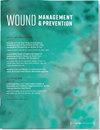肯尼迪病变(肯尼迪末期溃疡)的早期皮肤温度特征。
IF 0.8
4区 医学
Q4 DERMATOLOGY
引用次数: 1
摘要
背景压力损伤与皮肤温度变化有关,但对肯尼迪损伤(KL)的皮肤温度特征知之甚少。本研究的目的是使用长波红外热像图描述KL早期的皮肤温度变化。方法通过对10名ICU患者的图表回顾,确定了ODSKL。在新的皮肤变色后24小时内进行皮肤评估。使用长波红外热成像系统进行温度测量。计算变色区域和选定控制点之间的相对温差(RTD)。大于+1.2摄氏度和小于-1.2摄氏度的RTD被认为是异常的。人口统计学数据和KL的可观察特征在可用时收集。使用描述性统计(平均值加/减SD;%)。结果本研究的主要发现是KLs和周围皮肤之间没有早期皮肤温度差异。结论KL的早期可能局限于微血管损伤,导致皮肤温度正常。需要更多的研究来验证这一发现,并确定KL皮肤温度是否随时间变化。该研究还支持在床边使用热成像技术评估皮肤温度。本文章由计算机程序翻译,如有差异,请以英文原文为准。
Early Skin Temperature Characteristics of the Kennedy Lesion (Kennedy Terminal Ulcer).
BACKGROUND
Pressure injuries are associated with skin temperature changes, but little is known about skin temperature characteristics of the Kennedy Lesion (KL).
PURPOSE
The purpose of this study was to describe early skin temperature changes in KLs using long-wave infrared thermography.
METHODS
KLs were identified from chart review in 10 ICU patients. Skin assessments were performed within 24 hours of new skin discoloration. Temperature measurements were performed using a long-wave infrared thermography imaging system. Relative Temperature Differential (RTD) between the discolored area and a selected control point was calculated. RTDs of > +1.2 degrees C and < -1.2 degrees C were considered abnormal. Demographic data and observable characteristics of the KL were collected when available. Descriptive statistics (Mean plus/minus SD; % ) were used.
RESULTS
The major finding of this study was that there were no early skin temperature differences between the KLs and surrounding skin.
CONCLUSION
The early stage of the KL may be limited to microvascular injury which results in a normal skin temperature. More studies are needed to verify this finding and to ascertain whether KL skin temperature changes over time. The study also supports the bedside use of thermography in skin temperature assessment.
求助全文
通过发布文献求助,成功后即可免费获取论文全文。
去求助
来源期刊

Wound management & prevention
Nursing-Medical and Surgical Nursing
CiteScore
1.70
自引率
8.30%
发文量
41
期刊介绍:
Information not localized
 求助内容:
求助内容: 应助结果提醒方式:
应助结果提醒方式:


